Notice
This is not the latest version of this item. The latest version can be found at:https://dspace.mit.edu/handle/1721.1/135688.2
Manuka honey microneedles for enhanced wound healing and the prevention and/or treatment of Methicillin-resistant Staphylococcus aureus (MRSA) surgical site infection
| dc.contributor.author | Frydman, Galit H | |
| dc.contributor.author | Olaleye, David | |
| dc.contributor.author | Annamalai, Damodaran | |
| dc.contributor.author | Layne, Kim | |
| dc.contributor.author | Yang, Illina | |
| dc.contributor.author | Kaafarani, Haytham MA | |
| dc.contributor.author | Fox, James G | |
| dc.date.accessioned | 2021-10-27T20:28:48Z | |
| dc.date.available | 2021-10-27T20:28:48Z | |
| dc.date.issued | 2020 | |
| dc.identifier.uri | https://hdl.handle.net/1721.1/135688 | |
| dc.description.abstract | © 2020, The Author(s). Manuka honey (MH) is currently used as a wound treatment and suggested to be effective in Methicillin-resistant Staphylococcus aureus (MRSA) elimination. We sought to optimize the synthesis of MH microneedles (MHMs) while maintaining the MH therapeutic effects. MHMs were synthesized using multiple methods and evaluated with in vitro assays. MHMs demonstrated excellent bactericidal activity against MRSA at concentrations ≥ 10% of honey, with vacuum-prepared honey appearing to be the most bactericidal, killing bacterial concentrations as high as 8 × 107 CFU/mL. The wound-healing assay demonstrated that, at concentrations of 0.1%, while the cooked honey had incomplete wound closure, the vacuum-treated honey trended towards faster wound closure. In this study, we demonstrate that the method of MHM synthesis is crucial to maintaining MH properties. We optimized the synthesis of MHMs and demonstrated their potential utility in the treatment of MRSA infections as well as in wound healing. This is the first report of using MH as a substrate for the formation of dissolvable microneedles. This data supports the need for further exploration of this new approach in a wound-healing model and opens the door for the future use of MH as a component of microneedle scaffolds. | en_US |
| dc.language.iso | en | |
| dc.publisher | Springer Science and Business Media LLC | en_US |
| dc.relation.isversionof | 10.1038/S41598-020-70186-9 | en_US |
| dc.rights | Creative Commons Attribution 4.0 International license | en_US |
| dc.rights.uri | https://creativecommons.org/licenses/by/4.0/ | en_US |
| dc.source | Scientific Reports | en_US |
| dc.title | Manuka honey microneedles for enhanced wound healing and the prevention and/or treatment of Methicillin-resistant Staphylococcus aureus (MRSA) surgical site infection | en_US |
| dc.type | Article | en_US |
| dc.relation.journal | Scientific Reports | en_US |
| dc.eprint.version | Final published version | en_US |
| dc.type.uri | http://purl.org/eprint/type/JournalArticle | en_US |
| eprint.status | http://purl.org/eprint/status/PeerReviewed | en_US |
| dc.date.updated | 2021-09-13T15:01:22Z | |
| dspace.orderedauthors | Frydman, GH; Olaleye, D; Annamalai, D; Layne, K; Yang, I; Kaafarani, HMA; Fox, JG | en_US |
| dspace.date.submission | 2021-09-13T15:01:24Z | |
| mit.journal.volume | 10 | en_US |
| mit.journal.issue | 1 | en_US |
| mit.license | PUBLISHER_CC | |
| mit.metadata.status | Authority Work and Publication Information Needed | en_US |
| mit.metadata.status | Authority Work and Publication Information Needed |
